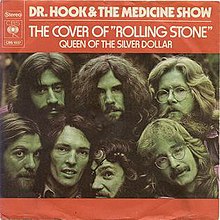The Cover of "Rolling Stone"
This article needs additional citations for verification. (March 2014) |
| "The Cover of 'Rolling Stone'" | ||||
|---|---|---|---|---|
 | ||||
| Single by Dr. Hook & the Medicine Show | ||||
| from the album Sloppy Seconds | ||||
| B-side | "Queen of the Silver Dollar" | |||
| Released | 26 October 1972[1] | |||
| Recorded | 1972 | |||
| Genre | Skiffle, pop rock, country rock,[2] comedy | |||
| Length | 2:53 | |||
| Label | Columbia | |||
| Songwriter(s) | Shel Silverstein | |||
| Producer(s) | Ron Haffkine | |||
| Dr. Hook & the Medicine Show singles chronology | ||||
| ||||
"The Cover of 'Rolling Stone'" is a song written by Shel Silverstein and first recorded by American rock group Dr. Hook & the Medicine Show. Produced by Ron Haffkine and released in 1972, it was the band's third single and peaked at No. 6 on the U.S. pop chart for two weeks on March 17–24, 1973.
Song information

The song satirizes success in the music business; the song's narrator laments that his band, despite having the superficial attributes of a successful rock star (including drug usage, "teenage groupies, who'll do anything we say" and a frenetic guitar solo) has been unable to "get their pictures/on the cover of the Rolling Stone".
As the song was riding high on the charts, the magazine finally acquiesced to Dr. Hook's request — after a fashion: the March 29, 1973, cover of Rolling Stone did indeed feature the band, but in caricature form rather than in a photograph (and with only three of the band's seven members). Also, the group's name was not used; instead the caption read simply, "What's-Their-Names Make the Cover."
BBC Radio refused to play the song, as it contained the name of a commercial publication (Rolling Stone) and could therefore be considered advertising. An urban legend states that the song was re-recorded by the band as "The Cover of the Radio Times", the weekly television and radio guide published by the BBC; however, this is disputed by Dennis Locorriere, Dr. Hook's co-lead singer. "Legend has it that we went into a studio and rerecorded the song. What actually happened was that a bunch of BBC disc jockeys went into a studio and shouted 'RADIO TIMES' over our original chorus," Locorriere said. "It's the same recording that we released but with the addition of their voices layered on top of ours. You can, however, still hear us singing 'Rolling Stone,' but way in the background, under their voices." The new version was rush-released in the UK, but did not find its way onto the charts there.[3] However the band's UK publicists took advantage of the BBC's uptight attitude by advertising the single in the UK music press as "the first banned single of 1973".
Chart performance
Weekly charts
|
Year-end charts
|
Cover versions
The song has been covered by various artists, including R. Stevie Moore on his 1987 album Teenage Spectacular; Poison on their 2000 album Crack a Smile... and More!; Sammy Kershaw on his 2010 album Better Than I Used to Be, with his version featuring Jamey Johnson; Black Francis on the album Twistable, Turnable Man: A Musical Tribute to the Songs of Shel Silverstein in 2010, and Jackyl on their 2012 studio album Best in Show.
Additionally, Buck Owens and the Buckaroos adapted the song as "On the Cover of the Music City News" on the 1974 album It's A Monster's Holiday and the 1976 album Best of Buck Owens, Volume 6.
German comedian Mike Krüger covered and translated the song with small lyrical changes for his 1978 album Stau mal wieder, changing the title to "Auf der Hülle mit den Rolling Stones" (On the Cover with the Rolling Stones), lyrics implying he would like to have his photograph as an album cover for the Rolling Stones.
In 1987 Dutch band Bertus Staigerpaip released a parody: "De veurplaat van d'n Donald Duck" (the cover of the Donald Duck - the latter having been a highly popular comics magazine in The Netherlands for many decades).
Phish played the song live in concert on February 14, 2003 after learning they would appear on the cover of the March 6, 2003 issue of the magazine.
The song has also been covered with the changes to the lyrics and used as social satire and civil protest against alleged corporate malfeasance and landlord abuses as Ode to Dark Avalonbay.
Further utilization
The song was featured in the 2000 film Almost Famous.
See also
References
- ^ https://www.45cat.com/record/445732
- ^ Pop/Rock » Soft Rock » Soft Rock. "Soft Rock | Significant Albums, Artists and Songs". AllMusic. Retrieved 2014-03-24.
{{cite web}}: CS1 maint: multiple names: authors list (link) - ^ Jerry Osborne. "Mr. Music". Retrieved 2017-01-05.
- ^ Kent, David (1993). Australian Chart Book 1970–1992. Australian Chart Book. ISBN 0-646-11917-6.
- ^ RPM Top Singles, April 14, 1973
- ^ "Dr. Hook & The Medicine Show – The Cover Of 'Rolling Stone'" (in Dutch). Single Top 100. Retrieved June 14, 2018.
- ^ Flavour of New Zealand, 21 May 1973
- ^ "Dr Hook Chart History (Hot 100)". Billboard. Retrieved June 14, 2018.
- ^ "Cash Box Year-End Charts: Top 100 Pop Singles, March 31, 1973". Archived from the original on July 15, 2014. Retrieved April 23, 2018.
- ^ Top 100 Singles of 1973 in Canada
- ^ "Cash Box Year-End Charts: Top 100 Pop Singles, December 29, 1972". Archived from the original on July 15, 2014. Retrieved April 23, 2018.
